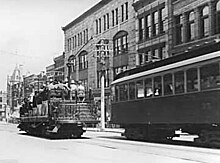British Columbia Electric Railway

BCER sightseeing trolley car on Granville Street in Vancouver (1910)
|
|
| Locale | southwestern British Columbia and Vancouver Island |
|---|---|
| Dates of operation | 1897–1979 |
| Predecessor | National Electric Tramway and Lighting Company Limited (1890); Vancouver Electric Railway and Light Company Limited (1890); Westminster and Vancouver Tramway Company (1891) |
| Successor | BC Hydro, Southern Railway of British Columbia |
| Track gauge | 4 ft 8 1⁄2 in (1,435 mm) standard gauge |
| Headquarters | Vancouver, BC |
The British Columbia Electric Railway (BCER) was an historic railway which operated in southwestern British Columbia, Canada. Originally the parent company, and later a division, of BC Electric, the BCER assumed control of existing streetcar and interurban lines in southwestern British Columbia in 1897, and operated the electric railway systems in the region until the last interurban service was discontinued in 1958. During and after the streetcar era, BC Electric also ran bus and trolleybus systems in Greater Vancouver and bus service in Greater Victoria; these systems subsequently became part of BC Transit, and the routes in Greater Vancouver eventually came under the control of TransLink. Trolley buses still run in the City of Vancouver and one line extends into Burnaby.
Streetcar and interurban services were inaugurated in southwestern British Columbia between 1890 and 1891, operated by the following companies:
With the global depression in the 1890s, all three companies went into receivership, and were amalgamated in 1895 into the Consolidated Railway and Light Company. The newly founded company was forced into receivership again after a streetcar accident in Victoria (the Point Ellice Bridge Disaster) resulted in 55 deaths, and was reorganized as the British Columbia Electric Railway Company Limited in April 1897.
Power was supplied by then-innovative diversion projects at Buntzen Lake and on the Stave River system farther east, all of which were built primarily to supply power for the interurbans and street railway.
Vancouver-Marpole
BCER began the Vancouver-Steveston interurban and freight service in 1905 after leasing the line from Canadian Pacific Railway (CPR) and electrifying it. The Vancouver-Marpole line's right-of-way (whose northern section runs beside Arbutus Street) remained under the ownership of the CPR, which continued running freight trains on the corridor until June 2001. With the end of freight operations on the line in sight, Vancouver City Council adopted the Arbutus Corridor Official Development Plan in 2000, designating the corridor as a transportation/greenway public thoroughfare to prevent other types of development from taking place along the right-of-way.
...
Wikipedia
